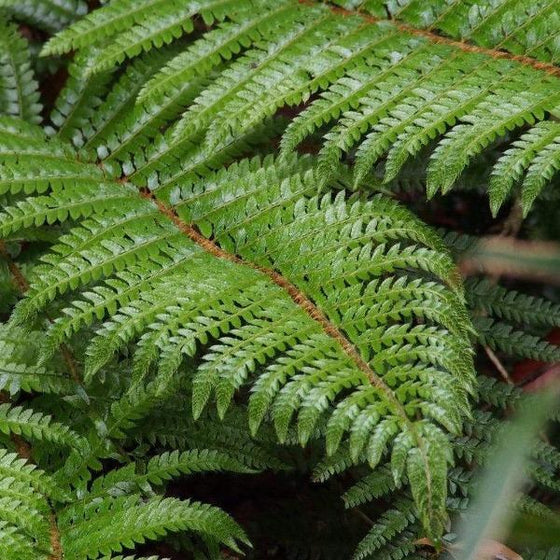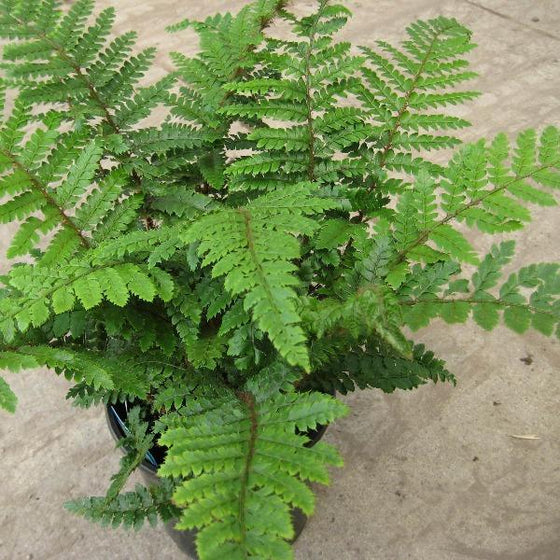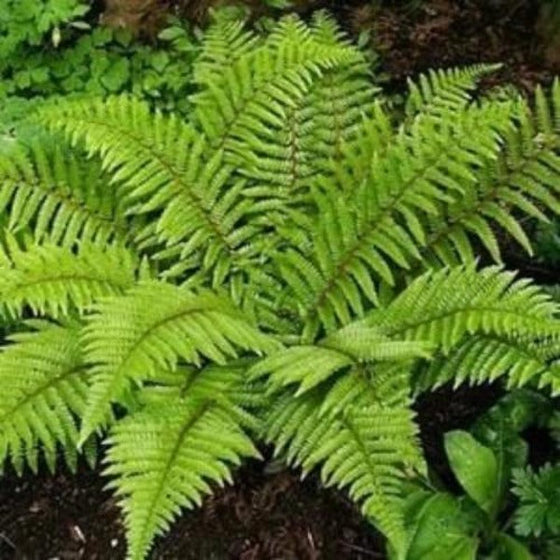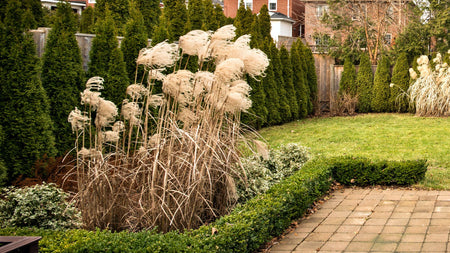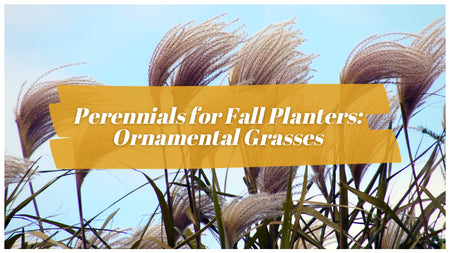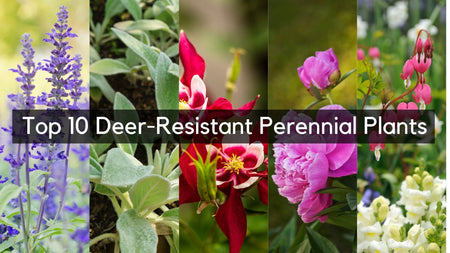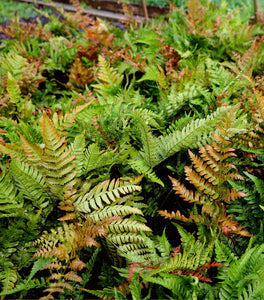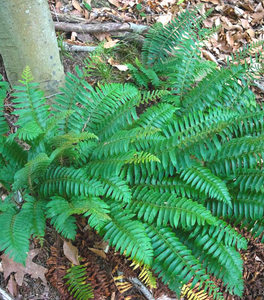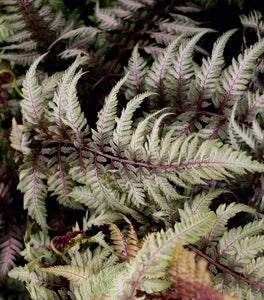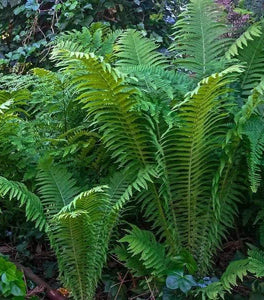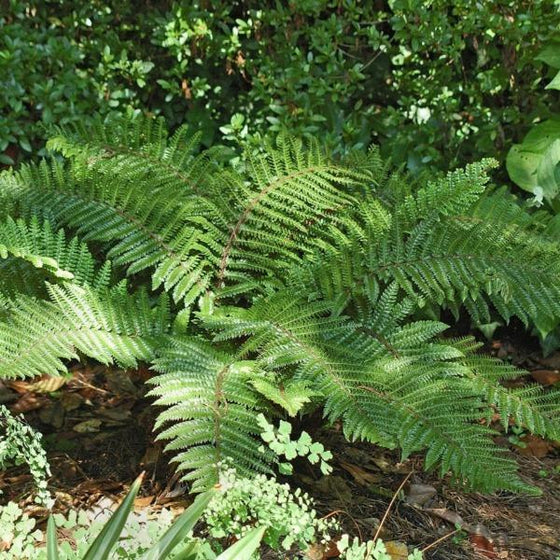
Images Depict Mature Plants
Tassel Fern for Sale Online
The Tassel Fern (Polystichum polyblepharum) is an elegant, evergreen fern known for its glossy, arching fronds that add a lush, graceful texture to shaded gardens and woodland areas. Its distinctive tassel-like fronds unfurl with a unique downward curve, giving this fern its charming name and a soft, flowing appearance. Perfect for adding year-round interest, the Tassel Fern thrives in low-light environments, making it an excellent choice for shaded borders, underplanting, or woodland garden designs. Its rich green foliage remains vibrant through the seasons, creating a calming, natural backdrop that enhances any landscape.
Hardy in USDA Zones 5-8, the Tassel Fern reaches a mature height and spread of 18-24 inches, forming dense clumps that serve as excellent ground cover. This fern prefers partial to full shade and moist, well-drained soils but can tolerate various soil types, including sandy and loamy conditions. While relatively low-maintenance, the Tassel Fern benefits from regular watering, particularly during dry spells, to maintain its glossy appearance. Its ability to thrive in deep shade makes it ideal for underplanting beneath trees, along shaded pathways, or in sheltered garden corners where other plants may struggle.
In addition to its aesthetic appeal, the Tassel Fern is deer-resistant, providing an extra layer of protection for gardens in areas prone to wildlife activity. Its low-maintenance needs and evergreen nature make it an excellent choice for gardeners seeking year-round beauty with minimal upkeep. Whether used in mass plantings, as a focal point in shaded gardens, or in containers, the Tassel Fern adds elegance and texture to any landscape, offering long-lasting appeal in a variety of garden settings.
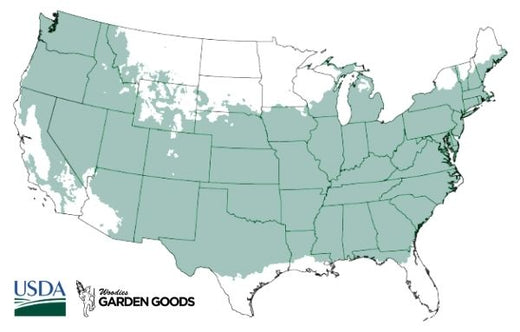
| Hardiness Zone: | 5-8 |
|---|---|
| Mature Height: | 1.5 to 2 feet |
| Mature Width: | 1.5 to 2 feet |
| Sunlight: | Partial shade to full shade |
| Water Requirements: | Water well until established and during times of drought |
How to Care for Tassel Fern
Before you buy a Tassel Fern, make sure to read about the care instructions that are required and recommended to keep this plant healthy and thriving.
How Do I Plant Tassel Ferns?
To plant Tassel Ferns (Polystichum polyblepharum), begin by selecting a location with partial to full shade, as this evergreen fern thrives in low-light environments. Choose well-draining, moist soil enriched with organic matter, such as compost, to provide the ideal growing conditions. Start by digging a hole twice the width of the fern’s root ball and deep enough so that the top of the root ball is level with the surrounding soil. Place the fern in the hole, backfill it with soil, and gently firm it around the base to remove air pockets. After planting, water thoroughly to help the fern settle and establish its roots. Spacing is important when planting multiple Tassel Ferns; place them 18 to 24 inches apart to allow room for their mature spread. Mulching around the base of the plant with organic material, such as bark or leaf mulch, will help retain moisture and maintain a cool root environment. Regular watering is key, especially during dry periods, to keep the soil consistently moist but not waterlogged. With proper planting and care, Tassel Ferns will thrive, providing lush, glossy fronds that add year-round texture and beauty to shaded borders, woodland gardens, and underplanting.
How Do I Water Tassel Ferns?
To water Tassel Ferns it’s important to maintain consistent moisture in the soil, as this evergreen fern thrives in a cool, moist environment. After planting, water thoroughly to help the roots establish, and continue to keep the soil evenly moist, especially during the first growing season. Water deeply once or twice a week, depending on rainfall and temperature, ensuring the soil remains consistently damp but not waterlogged. Mulching around the base of the fern can help retain moisture and prevent the soil from drying out too quickly, which is especially beneficial during warmer months. Once Tassel Ferns are established, they still prefer consistently moist soil, so regular watering is key, particularly during periods of dry weather or high heat. Monitor the soil to ensure it doesn’t dry out completely, and adjust your watering schedule based on the season and climate. While these ferns enjoy moisture, avoid overwatering or letting the plant sit in standing water, as this can lead to root rot. By keeping the soil evenly moist and ensuring proper drainage, Tassel Ferns will maintain their lush, glossy fronds and thrive in shaded garden areas.
How Do I Fertilize Tassel Ferns?
To fertilize Tassel Ferns use a balanced, slow-release fertilizer in early spring to promote healthy growth and vibrant fronds. A 10-10-10 formula works well, providing the essential nutrients of nitrogen, phosphorus, and potassium. Apply the fertilizer around the base of the fern, making sure to avoid direct contact with the foliage to prevent burning. After fertilizing, water thoroughly to help the nutrients penetrate the soil and reach the fern’s root system. For a more organic approach, you can add compost or well-rotted manure, which enriches the soil and provides a steady release of nutrients throughout the growing season. Once Tassel Ferns are established, they typically require minimal fertilization, as they thrive in organically rich, well-drained soils. If the fern is planted in poor or depleted soil, a light mid-season feeding can help maintain its lush, green foliage. Be careful not to over-fertilize, as excessive nutrients can lead to weak, spindly growth. By following a simple fertilization routine and enriching the soil with organic matter, Tassel Ferns will continue to thrive, offering year-round texture and elegance to shaded gardens, woodland areas, and borders.

How Do I Prune Tassel Ferns?
To prune Tassel Ferns the best time is in late winter or early spring, just before new growth begins. Start by removing any dead, damaged, or discolored fronds, using sharp pruning shears to cut them at the base. This helps promote healthy new growth and keeps the fern looking tidy and vibrant. Be careful not to cut off any healthy green fronds, as these contribute to the plant’s overall health and help it photosynthesize. Pruning also improves airflow around the plant, which helps prevent fungal diseases and encourages robust growth. During the growing season, Tassel Ferns generally require minimal pruning. However, if you notice any fronds that become damaged or browned due to environmental factors, you can trim them off to maintain the plant’s appearance. Regularly removing dead or faded fronds keeps the fern looking fresh and prevents debris from accumulating around the base, which could harbor pests. By pruning your Tassel Ferns properly, you can ensure that they remain healthy, lush, and full of their signature glossy fronds, adding year-round texture and beauty to your shaded garden or woodland landscape.

